Here is a short video of Pedran on that day, the last time we saw her:
PEDRAN: What has happened to her?
Pedran's Last Day (https://www.youtube.com/watch?v=KibIxmIXVNk&ab_channel=DyfiOspreyProject)
Pedran's Last Day on the Dyfi Nest
So, as usual at this time of year, we publish the bar chart of all the last-seen ages of all the Dyfi offspring. This is how Pedran fits in with the preceding 25 youngsters that made it to this stage:
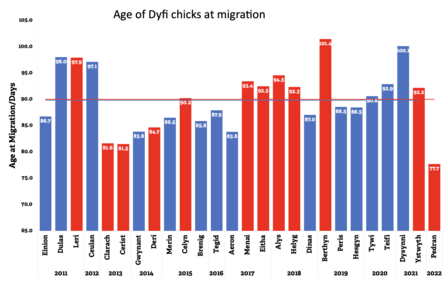
Age at Migration of All Dyfi Chicks
So Pedran is the youngest to go by around four days. Clarach and Cerist were last seen at 81 days old, and we know at least one of these returned to the UK and successfully bred as an adult (Clarach).
So, 77.7 days old doesn't seem that anomalous given a bit of context.
And you know what they say about statistics... The y-axis on the chart starts at 65 days old, so we can better see the variation between each bird. But if we choose to start the chart at '0', this again gives a truer picture of the variation between birds:
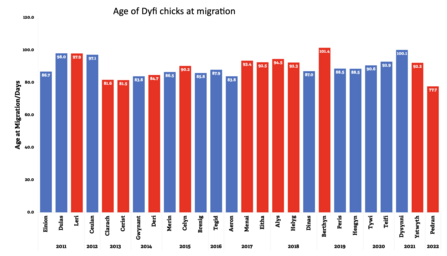
Age at Migration of All Dyfi Chicks - starting at age zero
So, notice now that the jump in age from Pedran to all the others is not as dramatic as first thought?
And a third bit of context for you: We know of other ospreys that have migrated even younger than Pedran - and make it back to the UK in future years. Only this week the guys at Leicestershire and Rutland Wildlife Trust reported that one of their 2022 juveniles had started her migration, she was spotted in Europe on 15th August.
Another Rutland offspring left even earlier this year; Blue 1H2 departed Manton Bay on 8th August.
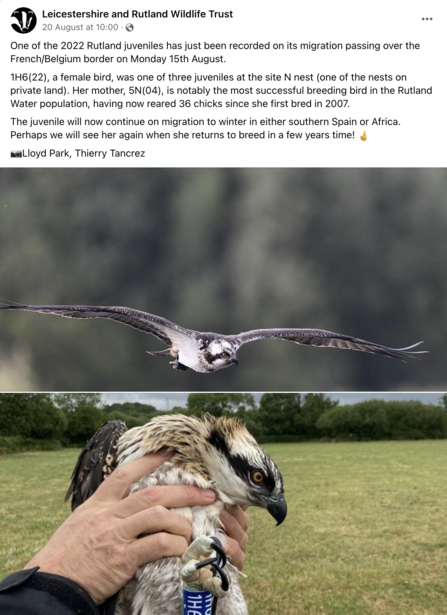
Rutland's Chick Blue 1H6 was in France by 15th August.
By the way, this offspring's mother, 5N, is Glesni's mother and Telyn's auntie; 2022 is her 16th year breeding. What a bird!
Another 2022 offspring, a Kielder (Northumberland) bird, again an oldest chick, was last seen in Kielder on 10th August, a day earlier even than Pedran. This bird has been officially sighted on the Llobregat Delta near Barcelona twice in the last few days.
So Why did Pedran Leave so Early?
Here are four good reasons as to why we last saw Pedran at just 77.7 days old:
1. The 'Last Seen' bit
We always have to be careful that we don't assume that youngsters migrate at the same time as we last saw them.
We know that some birds prefer the nest as a kind of home-base for fish deliveries, while other individuals are quite happy to be waited upon on the marsh or further down the estuary. Pedran could well have loitered on the Dyfi for a few more days, being fed off-nest by either or both parents.
2. Pedran was the oldest of the three
We know from previous years that the 1st chick, the oldest, tends to migrate (last seen) first. They seem to get that independence vibe a bit earlier than younger siblings.
1st chicks are the red bars - they tend to migrate earlier than their siblings, on average (2021 data will be added soon).
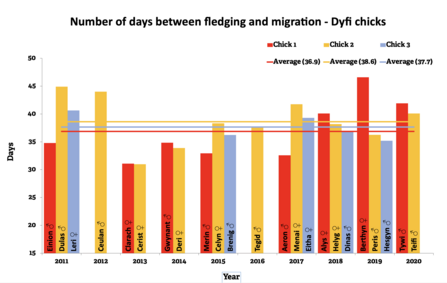
Fledging to Migration Ages of all Dyfi Chicks.
3. Weight and Size
Pedran was already nearly 1700g by the time she was weighed at 34.8 days old. She was healthy, well developed and had all her flight feathers 100% developed by the time we last saw her at 77.7 days old.

Dyfi Chicks 2022
4. Pedran is a MALE!
We know (see below) that male offspring tend to leave a bit earlier than females.
You have to remember that we have to make a quick determination at the bottom of the nest when we ring the birds as to whether we have males or females. It's not an exact science. We work as quickly as possible so that the whole family are disturbed for the least amount of time. We don't faff about.
The girth of the tarsi (leg bones) is an important gauge that we use (females having fatter legs than the boys on average). But overall body weight is also a big factor.
The chicks were ringed and weighed on 27th June. Now, two months later, we know a lot more about each offspring. We now have important ecological metrics that we did not have in June.
Here are five reasons that I, personally, think that Pedran is most probably a boy:
1. Body Weight
The youngest chick (1830g) is 8% heavier than the oldest (1695g) - see above chart. We thought this was odd at the nest in June if our three-female estimation was correct, so we measured them twice in case we had made a mistake. We hadn't.
We also checked their 'order'; again, we're pretty sure we did not mix them up.
One very simple explanation as to why a chick four days younger than its sibling would weigh 8% more is the fact that he is a male. Female ospreys weigh around 15% more than males when fully grown. The weight measurements we took at the nest in June fit perfectly into this scenario.
2. Photographic Evidence of Body Size
Once all three youngsters had fledged, we had many opportunities to physically view the (almost) fully-grown siblings and compare them to each other. Pedran just looked a bit slimmer and smaller than the other two.
Paith left, Pedran right.
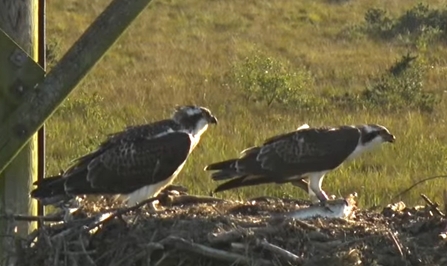
Paith left, Pedran right.
3. Fledging Age
Pedran fledged at just 50.9 days old - this is even younger than the average for all previous male chicks. It's also three days younger than the other two chicks.
🦅 15th July: PEDRAN fledges at 15:05 at 50.9 days old
🦅 19th July: PADARN fledges at 15:07 at 53.9 days old
🦅 21st July: PAITH fledges at 13:49 at 54.2 days old
Males tend to fledge before females, on average, as they are lighter. A fully-laden Boeing 747 departing Manchester Airport for The Gambia will take a lot longer to get airborne off the runway than a Boeing 737 going to the same destination carrying half that amount of people.
Would it not make more sense in the chart below if Pedran's histogram was blue?
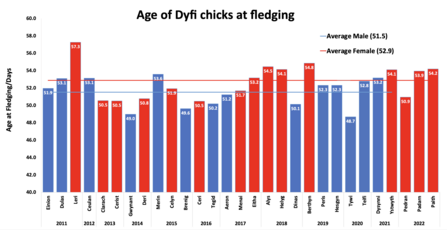
Age at Fledging of all Dyfi Chicks
4. Migration Age
We also know that males tend to migrate at a slightly younger age than their sisters.
Now, if we make Pedran blue on the Migration Chart, the very first chart you saw on this blog, this is what it would look like:
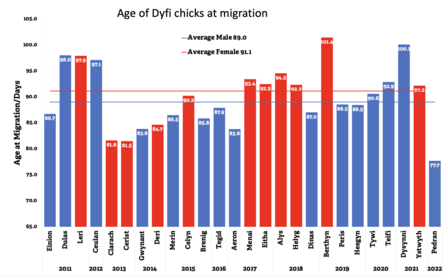
Pedran has the Blues.
Would this not make more sense?
Notice also that the average trend-lines have also opened up again to a 2-day difference between males and females... that's approximately the long-term age span variance we have recorded at this nest.
Finally on this point, now look again on the fledging-migrating chart where the first chicks are in red bars... so this is basically a chart showing how many days each bird was 'on the wing' before leaving.
Four of the first five 1st chicks we had at this nest (2011 - 2017) were males - just look how much earlier than their siblings Einion, Gwynant, Merin and Aeron were last seen; all below 35-days airborne. This is typical for males.
For reference, look how much longer 1st chicks (females) Berthyn and Alys took...

Fledging to Migration Ages of all Dyfi Chicks.
5. Idris the Super-Dad
This is the big one - and probably the clincher for me.
Idris has consistently raised larger offspring than Monty. They are significantly heavier birds.
Excluding Pedran for a moment, all of Idris' kids have been heavier than the average apart from one, Ystwyth.
In this table below, I have boxed all of Idris' offspring in green with an arrow showing the variance between trending average and actual weights. Look at Dysynni, Paith and Padarn!

Idris' Offspring in Green.
Monty was a great provider for his family, but has Idris been even better? He's certainly had Goldilocks weather for the most part during the three years he's been with us, which would have helped.
Idris, to me anyway, seems to be more receptive to Telyn's food soliciting calls. He appears to go fishing earlier when 'commanded'. Monty certainly had more selective hearing. £1.
So now look at Pedran on this chart above. Considering that 2022's Padarn and Paith are significantly heavier than average, as are 5/6ths of Idris' offspring, would it not also make sense that, particularly in the ideal weather season we've had in 2022, that the first-hatched chick, Pedran, would also be significantly heavier than the average?
Of course, he is if we make him blue.
And Finally
None of this makes any difference in the end. What matters is that we've had three very healthy looking youngsters in what has been a perfect breeding season. No dramas, no panic, just calm. We like boring.
This year is the first year in almost a decade that we did not take DNA samples, so the only living thing on earth that probably knows for sure is Pedran him/herself.
Going on previous data, Pedran has around a 40%-50% chance of surviving and making it back to the UK as an adult from 2024 onwards. If s/he does and we get a decent photo/video, we will know for sure.
With the new data we've had since June and after some careful consideration, I think that, on the balance of probability, Pedran is a male. We'll change our stats going forward to reflect Pedran's recent sex-change.
We last saw Telyn on Thursday, Idris was still bringing fish for his two remaining and demanding daughters yesterday, Padarn and Paith.
But, for now, I think we can safely say that Pedran has migrated, and given we last saw him 17 days ago, he could well be in Africa by now, while his two sisters are still screaming for fish thousands of miles away in Wales.
Now there's a thought.
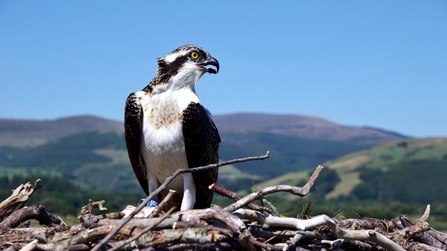
Pedran, just before he left on 11th August.
* 7th September Update: BREAKING NEWS: Pedran has been sighted in the UK*
He was spotted on 26th August - that's 15 days after we last saw him on the Dyfi - on Featherstone Bridge in Northumberland. This is around 175 miles north-east of the Dyfi.
We know that offspring that decide to leave early sometimes don't fly directly south, we've seen a few examples already this year.
Looks like Pedran was having a Staycation in the UK for a few weeks first before heading south.
Where he is now, we don't know of course, this sighting was from 12 days ago.
Let's hope he's doing well. His middle sister, Padarn, is still with us, four weeks after he left.
*Thank you so much to Steve Warren who reported Pedran via the Roy Dennis Wildlife Foundation ringing scheme website, and for allowing us to share the photo he took of our boy.*
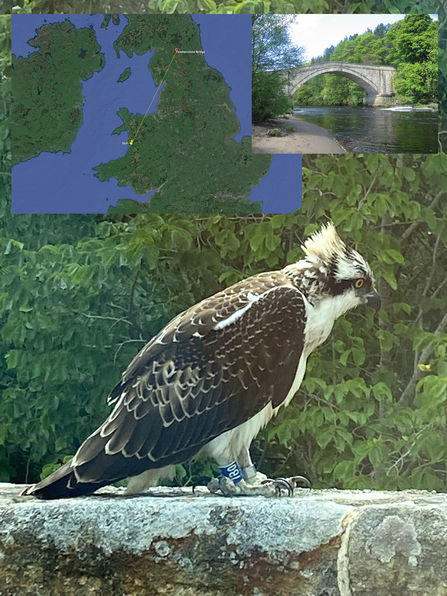
Pedran in Northumberland on 26th August
